Menu
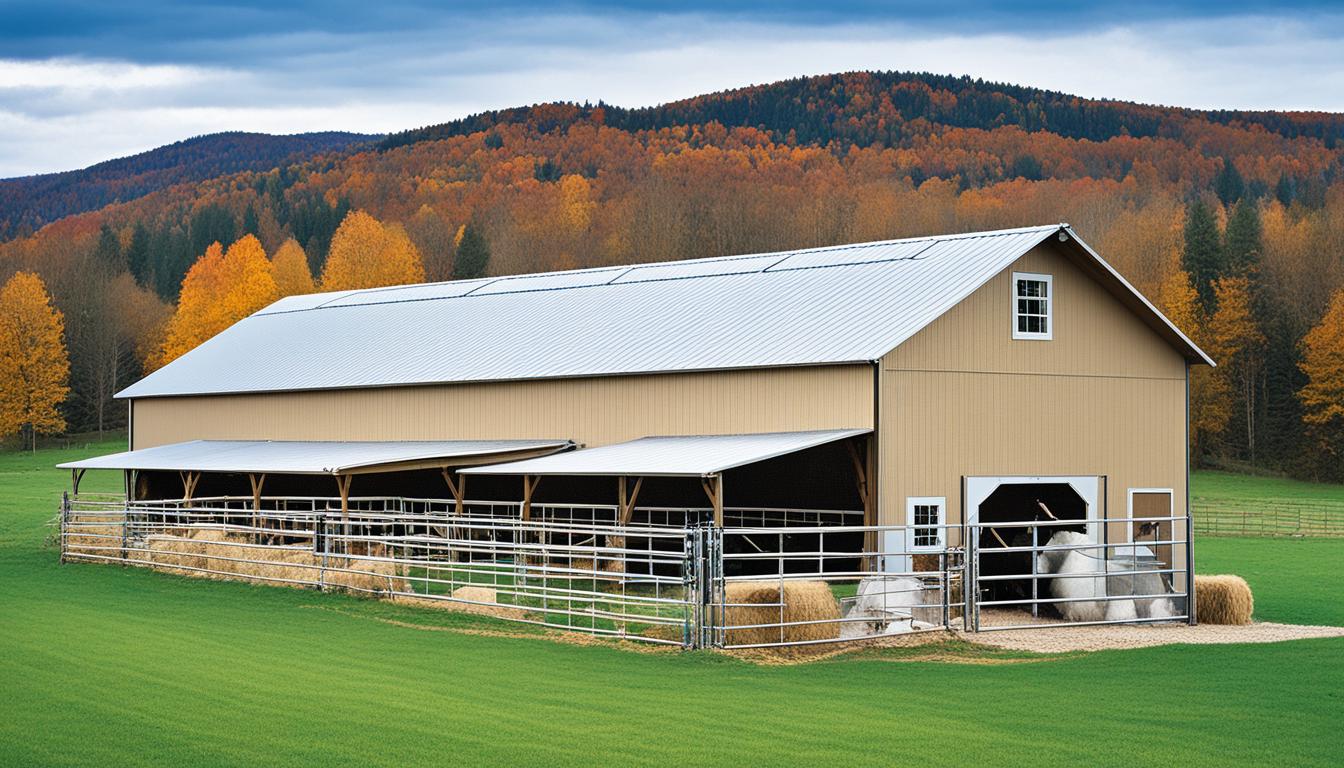
Did you know that up to 80% of people who go back to an evacuation site are doing it for a pet? This fact highlights the need for strong shelters for livestock and a good emergency plan. It’s vital to have a safe place for farm animals during crises like natural disasters. This keeps them and their owners safe and calm.
Before giving up an animal because of nowhere to house them, look at temporary options carefully. One good idea is asking friends or people in your community for help. Also, the Animal Care Centers of NYC can offer guidance through their Owner Surrender Service.
Livestock emergency shelters help a lot during natural disasters. They protect the animals. Plus, they stop farmers from facing big financial losses.
Floods, hurricanes, and tornadoes can be very dangerous for farm animals. It’s important to make sure animals have safe places to stay. This means buildings that can stand up to strong winds and heavy rain are needed. The USDA says it’s also key to keep animals cool or warm, depending on weather conditions. Using things like sprinklers and fans when it’s hot and giving them warm bedding in cold weather can save animal’s lives.
Losses from dead livestock can hit wallets hard. The AVMA says to always check that emergency kits have fresh food, water, and medicine. The Livestock Indemnity Program offers help for losses beyond the norm caused by weather. It shows ensuring animals’ safety during disasters is vital for both money and crisis control.
During emergencies, the welfare of animals should come first. Providing proper shelter, food, and water is the right thing to do. Animals should have enough room and good shelters to feel safe. This not only keeps them alive but also treats them humanely during tough times.
| Essential Kits | Recommended Items | Notes |
|---|---|---|
| Livestock Evacuation Kit | Feed, water, supplements, medications, cleaning supplies, veterinary records | Review contents regularly for freshness |
| Poultry Evacuation Kit | Leg bands, feed, water, cleaning supplies, bedding materials, extra feeders | Contact information required on leg bands |
It is key to understand the dangers livestock face during emergencies. We need to look at risks like bad weather, diseases, and accidents caused by people. This lets us put good plans in place to keep our animals safe.
Natural disasters such as hurricanes, wildfires, and floods are serious threats. They can halt farm work and harm animals. Diseases are also a big risk, especially for animals kept close.
Properly checking food and water to avoid any poisoning is important too. A good plan should also tackle cold and hot weather to protect animals. Making sure they have enough to eat and drink stops many problems.
Using microchips or tags helps to find animals if they get lost. Having places ready to shelter them in case of emergency is vital. Buildings where animals stay should be strong against weather and safe for them to live in.

Healthy livestock is a must, so they should be vaccinated. The USDA’s NAHERC team is ready to help if diseases spread. But, most people don’t have enough trailers for a quick getaway, so this needs careful planning too.
To wrap up, knowing and dealing with risks helps keep animals safe and farms running. Good plans protect our animals and our jobs.
Shelters for livestock in emergencies are really important. They keep animals safe and comfortable during unexpected situations. By making sure shelters are carefully designed and well-equipped, we can protect our animals better.
Emergency shelters need enough room, good airflow, and simple ways in and out. The place where animals stay should be strong and safe. It’s also smart to consider the weather when designing these shelters.
According to the USDA APHIS, each shelter should be about four times the size of the animals inside for them to move freely. It’s important to check shelters regularly to see if they can withstand tough weather like strong winds or heavy rain. The materials used for building a shelter must be strong but also provide comfort to the animals.
| Design Aspect | Recommendation |
|---|---|
| Space | Four times the body size |
| Ventilation | Adequate airflow with insulation options |
| Accessibility | Easy entry and exit for quick evacuation |
| Sturdiness | Materials capable of withstanding severe weather |
| Safety Checks | Regular assessments against high winds, heavy rains, snow |
It’s not enough to just build a shelter; you need to stock it with the right supplies. A backup generator is key, with enough fuel to last through power cuts. Don’t forget plenty of food, water, and medical kits for the animals.
Keeping some emergency cash is a good idea, as ATM’s might not work in a crisis. It’s also important to take steps towards fire safety, like removing dead trees and brush. This makes the area around the shelter safer.
It’s crucial to tag animals in case of an emergency. Livestock need to be easily recognised and accounted for. This simple step makes moving and keeping track of them much easier.
Good shelters should have ways to keep animals cool or warm, depending on the weather. Providing shade, ventilation, and bedding is essential for their well-being.
By carefully thinking about shelter design and having the right supplies, we can protect our animals. This preparation is key in keeping them safe and healthy during tough times.
During emergencies, moving livestock fast is key. *Portable livestock shelters* and *mobile barn solutions* are great for this. They help get animals to safety quickly, reducing stress and keeping routines as much as possible.
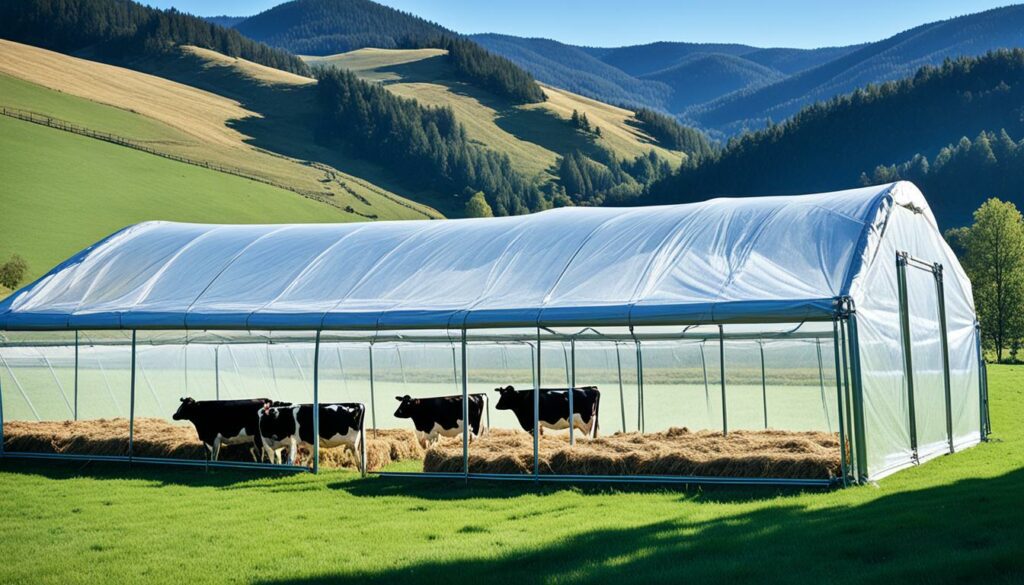
Temporary animal housing is done well with portable shelters. These structures can be set up very fast, which is vital in urgent times. They’re easy to move around, working well in many places. For example, the Michigan Humane Society uses them to help people in a pet crisis.
*Mobile barns* are another fine option for *temporary animal housing*. They can go anywhere, helping animals feel safe and at home in emergencies. The Humane Society of West Michigan’s P.E.T.S. Network uses them to aid pets in tough situations. This shows how important and useful mobile barns can be.
| Organisation | Program Description |
|---|---|
| Michigan Humane Society | Assists individuals with pet care during crises |
| I Heart Dogs Rescue | Haven for pets of domestic violence survivors |
| Humane Society of W. Michigan | Emergency housing for pets in various situations |
| Hope’s 2nd Chance Animal Sanctuary | Free temporary safe housing for various animals |
| Humane Society of Huron Valley | Safe Harbor Program for temporary pet housing |
Using *portable livestock shelters* and *mobile barns* in our emergency plans is smart. It ensures we care for animals and pets during hard times. Owners feel better knowing their animals are safe.
Durings emergencies, turning structures into shelters for animals helps protect livestock. The DHS and FEMA key in helping with resources for care and aid. ESF #6 supports this, underlining the need for housing like farm buildings for animals.
Farmers can make use of their current buildings, making them safe for animals. They can set up areas for different types of livestock. This helps fast action in emergencies and meets the needs of special groups, like those who need help with healthcare or transport.
Keeping animals healthy, physically and mentally, matters a lot. ESF #6 helps, making sure even those with service animals or helpers get care. It’s vital to think of these aspects when preparing farm buildings, ensuring a good space for animals.
The NRCC’s ESF #6 Branch and other ESF #6 teams work together for big emergencies. By fixing up existing buildings and planning their use, these structures can become good shelters for animals.
The Federal response community highlights caring for people’s physical and mental well-being. This includes those who rely on family or service animals and kids during critical times.
Studies by Dalla Villa P. et al. (2019) and Westcott R. et al. (2017) show animal welfare in emergencies is crucial. Repurposing farm structures is a smart, quick way to help animals without much extra building. It ensures they get care fast and their routines are less disrupted.
By using these methods, farm buildings can be a solid part of emergency plans. It looks after animals’ physical health and helps those in need of special care. This shows how the Federal teams aim for full support.
| Function | Description |
|---|---|
| Reinforcement | Strengthen existing structures to ensure they are durable and safe. |
| Partitioning | Create specific areas within structures for different species. |
| Resource Access | Provide access to food, water, and medical supplies within adapted shelters. |
| Safety Protocols | Implement comprehensive safety measures for animals and handlers. |
Constructing permanent shelters for livestock helps keep farm animals safe during emergencies. I’ll talk about planning and designing these shelters. This includes looking at costs and the benefits over time.
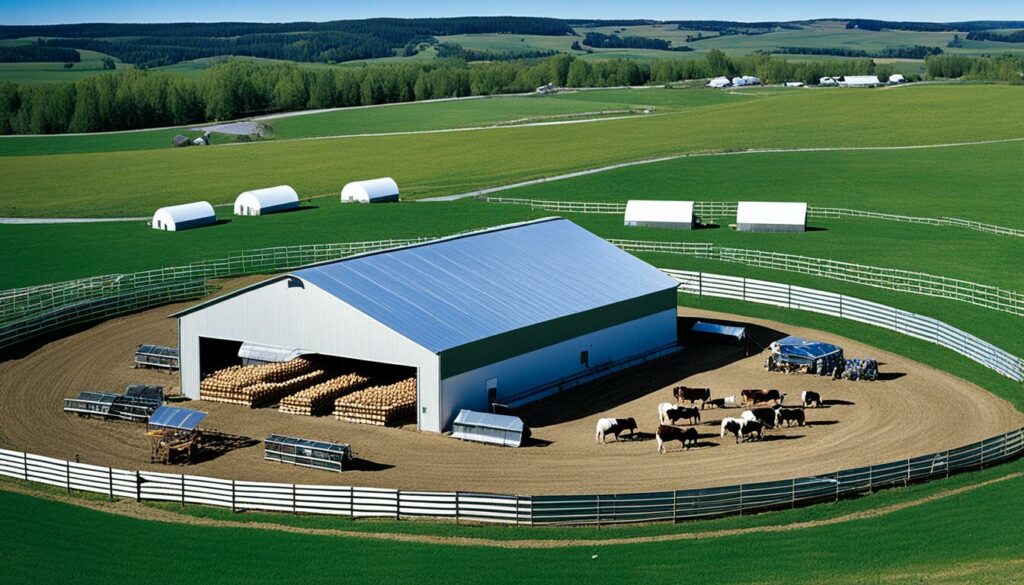
Good shelters start with planning and designing them well. They need to meet each type of animal’s needs. This means the shelters should: be the right size, have good ventilation, and be easily reached. This fits with what FEMA suggests for emergency plans, making them strong against disasters and safe for the animals inside.
Thinking about costs is key when making these shelters. The first cost might seem high, but it’s worth it for the long run. Federal help (thanks to the PETS Act of 2006 and FEMA) can lower these costs. This way, careful spending and smart choices make emergency plans last and work well.
Putting money into these shelters comes with lots of good points. It keeps animals safer, makes emergencies less stressful, and keeps the farm going. It also means emergency plans are solid, giving animals ongoing protection. So, these shelters do more than help right away; they make farms and communities stronger for the future.
All in all, looking at the planning, costs, and benefits of these shelters helps farmers protect their animals better. This is crucial in facing any emergency that might come their way.
When building shelters for animals, it’s vital to choose the right materials. We must also be mindful of the environment’s impact on the shelter’s design. This ensures the animals are safe and comfortable.
For durable and money-saving shelters, picking sustainable materials is key. Green-treated lumber is great for barns and kennels. It lasts longer and withstands harsh weather. Adding windows for natural light boosts animal health.
Dogs and cats’ indoor areas need good ventilation. This keeps the air fresh and avoids gas build-up during hot weather. For cleaning, make sure there’s hot and cold water available all the time.
It’s important to think about the surroundings when designing animal shelters. Local climate and possible natural disasters must be considered.
Indoor places should never drop below fifty degrees Fahrenheit to protect the animals. Good ventilation is a must to keep the air clean and lower stress. This avoids diseases and maintains their health.
Using fans can help lessen the number of flies. This makes the animals’ environment more comfortable and healthier.
| Animal Type | Minimum Floor Space | Additional Requirements |
|---|---|---|
| Dog | 90-100 square feet (average) | Ventilation, appropriate chain length |
| Cat | 45-50 square feet (average) | Minimum of 2.5 square feet per cat |
| Bird | Varied (2.5 per household) | Natural light, adequate space for movement |
Following these tips helps farmers and shelters go beyond just the basics. It ensures their facilities support the animals’ health and happiness.
Creating the right home for farm animals is crucial. It’s not just about space. We must also think about their age, type, and health. By considering all these, we can make their living areas better.
Bad weather is a big worry. Droughts and extreme cold can harm animals. To protect them, their shelters should keep them safe from strong winds and too much rain. Shelters also need to keep animals warm when it’s cold and cool when it’s hot.
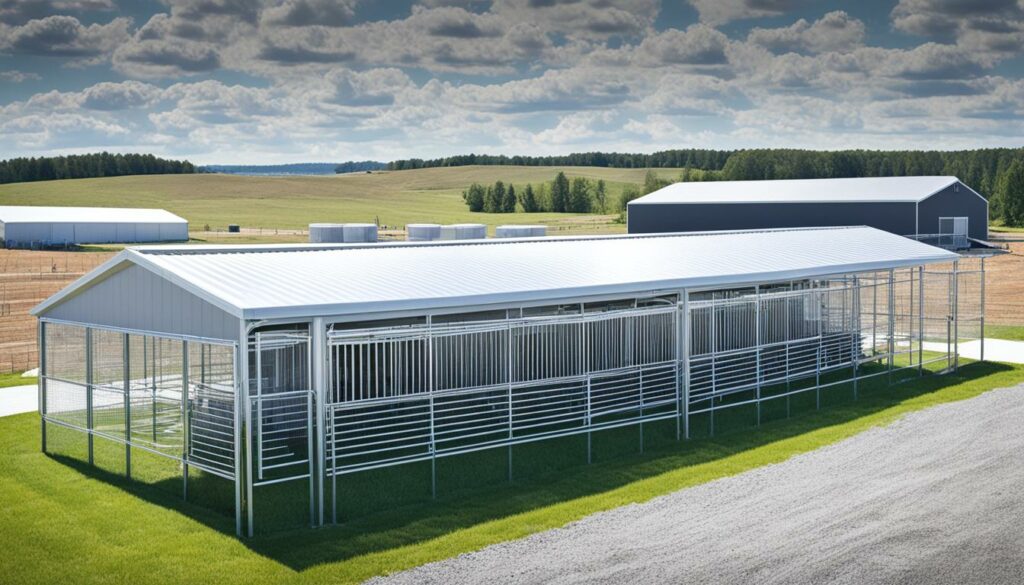
Being ready for disasters is key. A plan helps respond fast and keep animals safe. Essential items like food, water, and medical records must be kept in an emergency kit. It’s also important to regularly check that vehicles for moving animals are working well.
It’s smart to tag or chip every animal. This makes it easier to manage them in emergencies.
In good weather places, shelters should have enough room for the animals. For example, indoor areas for cows should be 35 to 40 square feet per cow. This lets them walk and rest comfortably.
Having someone who can look after your animals when you’re not there is a good idea. Also, having local officials and special help groups on speed dial is important. The National Animal Health Emergency Response Corps offers help in such times.
Planning for today and tomorrow is important in animal housing. Always have enough food and water for animals for at least three days. Plus, joining programmes that help in disasters can be lifesaving. Flexibility and being ready are the secrets to good animal management.
Looking after livestock during natural disasters is key. FEMA tells us that disasters like droughts, hurricanes and floods can really harm farm animals. To reduce these risks, it’s vital to have detailed emergency plans for them.
To get ready, I suggest making an emergency kit for your animals. It should have their food, water, and any needed medicine. Also, keep their health records, proof of ownership, and tools like ropes and halters. Be sure to add cleaning supplies as well. These steps help ensure you can help your animals right away if something bad happens.
If evacuation is needed, have a plan to move your animals safely. Planning ahead keeps things from getting too crazy and helps your animals stay safe. If you can’t leave, make sure your animals have a good place to stay and enough food and water. Include bedding to keep them warm and things to cool them down too.
Choosing a reliable neighbour to look after your animals if you’re not there can really help. Also, local groups like the National Animal Health Emergency Response Corps are ready to give a hand when you need it the most.
A well-thought-out plan can really boost the safety of your animals during disasters. Keep checking and improving this plan to stay ready for different dangers as they come.
| Emergency Item | Details |
|---|---|
| Feed and Water | Ensure at least a week’s supply |
| Supplements | Include necessary vitamins and minerals |
| Veterinary Records | Up-to-date health records and proof of ownership |
| Basic Supplies | Rope, halters, cleaning supplies |
| Shelter Essentials | Strong shelter, warm bedding, cooling options |
Looking at emergency shelters that worked well gives us good ideas. This is especially true for protecting animals during disasters like Hurricane Wilma and the California wildfires. They show how getting ready and being flexible saves lives.
During Hurricane Wilma, quick action and strong shelters kept livestock safe. They used:
These steps lowered the number of animals that died. It also kept the surviving animals healthy. This shows how important planning and using what’s available are.
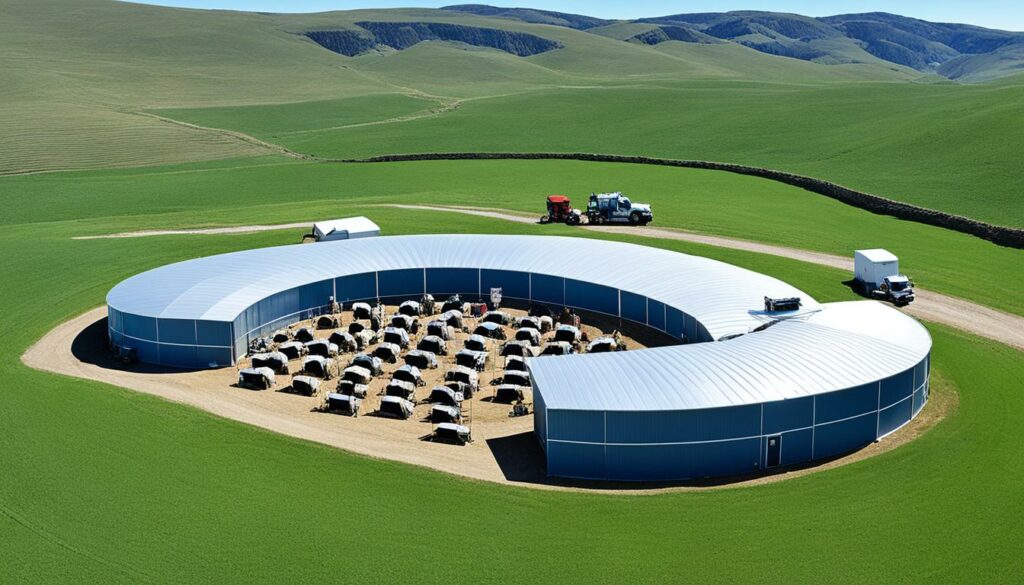
In the California wildfires, they had to act fast to save many animals. They used:
Thanks to these actions, a lot of animals were moved to safety. It underlines how important it is to have plans ready and work together during emergencies.
| Disaster | Key Strategies | Outcome |
|---|---|---|
| Hurricane Wilma | Temporary shelters, local help, food and medicine | Lives saved, animals kept well |
| California Wildfires | Quick shelters, medical aid, using farm buildings | Successful rescue, teamwork |
These stories from Hurricane Wilma and the California wildfires are powerful. They clearly show how being ready and acting fast can help protect animals during bad times.
Designing a comprehensive emergency guide for livestock is key. It needs thorough planning and teamwork. This guide must cover steps to keep animals safe and react fast in crises.
For a good livestock emergency response plan, clear roles and farm staff responsibilities are crucial. Everyone should know what to do when an emergency hits. This makes everything go more smoothly.
“Assigning specific duties to each staff member enhances the efficiency of the emergency response and improves animal welfare.”
Building a strong shelter that can endure bad weather is vital. Make sure it’s filled with all you need and the animals are easily identified. A team that knows what to do, with clear steps, and secure shelters is the heart of a good livestock emergency response plan.
During emergencies, it’s key to look after both the heart and body of animals. We need to think about their feelings as well as their health. Keeping animals safe means making sure they have food, water, and shelter. We have to think about their mental well-being too. Stress should be kept to a minimum. Basic care includes feeding and checking on them regularly. This stops them getting sick or hurt. The ‘five freedoms’ guide us on how to care for animals properly. This includes ensuring they are not hungry, thirsty, or in pain. They should also be able to act how they normally would and not feel scared. It’s vital to follow specific plans when things go wrong to protect animals.
In times of trouble, animals might act in ways we don’t expect. They might seem more anxious, make more noise, or move a lot. It’s crucial they feel as calm as possible since stress can make them physically unwell. People trained to help animals should watch over them regularly. This way, we can catch early signs of sickness or injury. To help keep them at ease, the surroundings must be right. This means the way they’re transported and the place they stay in. It really makes a big difference to an animal’s happiness in tough times.
In an emergency, we must watch out for the animals’ health, injuries, and giving birth. It’s critical they always have food, supplements, and clean water. Animals can get really poorly or even die within a day or two without water. Making sure they are correctly labelled, like with microchips, helps us look after them well. We can keep track of them and know they’re being cared for. Sometimes, moving animals is not possible. In such cases, putting them down in a humane way might be the only option. When animals are hurt, help them as soon as possible. This could be on the spot or in a place determined for their care post-evacuation. The goal is always to keep them as healthy as we can.
Options for emergency shelter include portable shelters and mobile barns. Also, making use of existing farm buildings is advised. These choices ensure quick protection and can change to fit different emergencies.
Natural disasters can cause big losses and hurt animals. It’s key to protect livestock for farm money and to keep animals safe.
Things like bad weather, diseases, and accidents are serious dangers. Knowing these risks helps to be ready for emergencies.
When building shelters, think about size, air quality, and how easy it is to get in and out. Also, make sure shelters have enough food, water, and medical help.
Portable shelters and mobile barns are great because they’re flexible and quick to set up. They help keep animals safe and calm during tough times.
Old farm buildings can be made better for emergencies by adding safety features and dividing spaces for different animals.
Think about the best use of space, costs, and the environment when designing shelters. This ensures animals are safe and comfortable in the long term.
Important tips include picking materials that are good for the planet, affordable, and right for the local weather. These make great shelters for animals.
Good plans make the most of space and help with maintenance and emergencies. They also boost the well-being of animals and the success of the farm.
It’s smart to have clear steps for emergencies, train workers, and always update plans. This helps keep the farm and the animals safe from disasters.
Studying past emergencies, like hurricanes and wildfires, shows the value of preparation and emergency shelters. It proves they protect animals well.
A good plan should have steps for before, during, and after the emergency. It must be clear who does what to keep the animals safe and healthy.
These places care for both the mental and physical health of animals. They understand how feelings affect health and make sure to help animals through tough times.